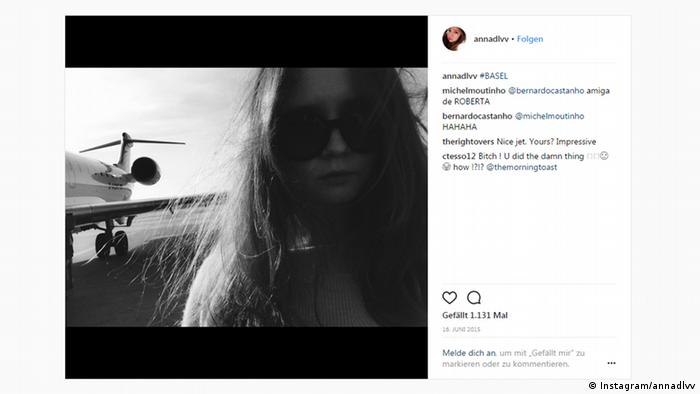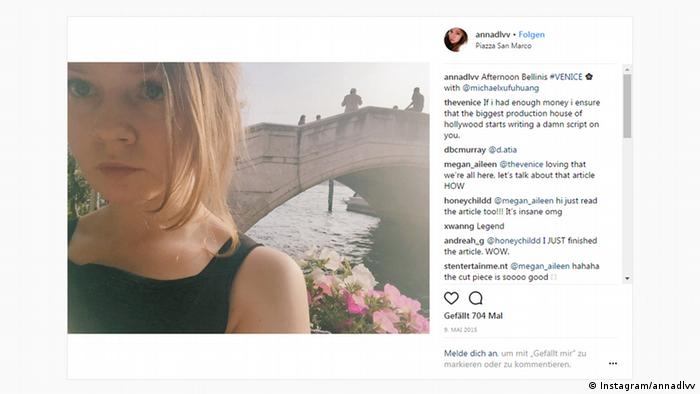As New York Magazine tells it, Anna Delvey lived a life that many young women in Europe could only dream of having: monthslong stays at trendy New York hotels, parties where she rubbed elbows with the jet-setting elite, hops across the Atlantic to attend art openings, strolls through Venice during the Biennale.
She once chartered a jet to Omaha for the Berkshire Hathaway annual investment conference to see Warren Buffett, spent a week in a private Moroccan riad on a whim and had dinner at gourmet restaurants with celebrities. And documented it all on Instagram along the way.
But social media access will likely be more difficult for Delvey, who has been in custody since her October 2017 arrest, after a judge on Thursday sentenced her to four to 12 years in prison following convictions on multiple counts of grand larceny and theft of services.
New York Judge Diane Kiesel said she was “stunned by the depth of the defendant’s deception” and turned down a request to count time already served towards her sentence.
How it started
In New York, Delvey had told acquaintances she was an heiress from a small town outside of Cologne, Germany and she was waiting on her trust fund before she could move on with her grand plans to open an art space in the city.
Her dream was to open this visual arts center at the historic Church Missions House at the corner of Park Avenue and East 22nd Street. She made moves to make that dream a reality, hiring a graphic designer to create a logo for the Anna Delvey Foundation and courting banks for loans in the millions.
The arts center never came to fruition. The life Anna Delvey had created for herself was all based on a series of scams.
By the time she was arrested in October 2017, she had left a pile of bad checks, unpaid bills and stiffed friends in her wake.
After her arrest on charges of grand larceny and attempted grand larceny, the faux heiress, who was born in Russia before moving to Germany as a child and whose real name is Anna Sorokin, sat down with writer Jessica Pressler for a New York Magazine exclusive interview, published on its lifestyle website, The Cut.
In the article, “Maybe She Had So Much Money She Just Lost Track of It,” Pressler speaks not only to Delvey but also to people who knew Delvey as a socialite in New York. She uncovers an unusual world — one in which both money and friends appears easy to come by. “Resilience is hard to come by,” Delvey tells the writer. “But not capital.”
Still, that capital is not her own. As Delvey’s father — a former trucker and manager of a middle-sized business who lives in Eschweiler, Germany — told New York Magazine: “Until now, we have never heard of any trust fund.”
This story, jokingly referred to by many on Twitter as the story of the “Soho Grifter,” got both the New York media world and the art world in a tizzy.
One acquaintance in Berlin, where Delvey is said to have interned in fashion PR, told New York Magazine that there were several individuals there who were apparently duped by Delvey. “She screwed basically everyone,” said the source.
Swindling the art world
One person who had been swindled — and who has faced Anna Delvey in court — is her former friend, Rachel Deloache Williams. A photo editor at Vanity Fair, Williams wrote in that magazine about her experience of being left holding the bag for a week’s stay in a five-star Moroccan villa.
“Seeking reimbursement from Anna became a full-time job. Stress consumed my sleep and fueled my days. My co-workers saw me unravel. I came to the office looking pale and undone,” Williams wrote.
Williams nevertheless managed to recoup her losses. In July 2019, she will publish her account of her relationship with the con artist, a book to be titled My Friend Anna; she obtained $300,000 (€268,000) for the the book deal. She also sold her story to HBO for $35,000.
Another prominent art collector who went on record as having been slighted is Michael Xufu Huang, with whom Delvey went to the Venice Biennale. The founder of Beijing’s M Woods Museum, Xufu Huang told New York Magazine that he found it odd that he was asked to put the plane tickets on his credit card but he later forgot her promises to pay him back, brushing it off as just being $2,000 or $3,000 owed.
Through her ruse, along with the “friends” she conned, she also managed to obtain a $100,000 loan from a bank and never paid it back. Altogether, prosecutors accuse her of stealing around $275,000.
How could these scams have carried on for so long? “It’s very much an art story,” said Ben Davis of Art Net in an article titled, “How Purple Magazine Intern-Turned-Scam Artist Anna Delvey Turned Contemporary Art Into the Perfect Tool for Fraud.”
“Take a look at Delvey’s Instagram and behold what a hollowed-out signifier art has become.”
“What interests me in the tale is how the sleight of hand that allowed Delvey to perpetrate her improbably long-lasting scam — flaunting the signifiers of wealth without the reality of wealth — is duplicated in the way a superficial association with art is so often confused with the love and appreciation of art,” he wrote.
The rights to the New York Magazine article have been acquired by Netflix and production company Shondaland. The company’s producer, Shonda Rhimes, best known as the author of the popular medical drama Grey’s Anatomy (2005), is attached to write the series.
This article was originally published at Deutsche Welle. Read the original article here.
Featured image credit: Instagram/@theannadlvv



